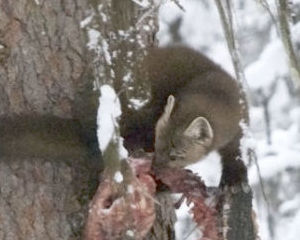Montana proposes for first pine marten transplant in 50 years
The state’s first translocation of pine marten in more than 50 years could take place if a Montana Fish, Wildlife and Parks proposal goes forward.
The agency plans to ask the Fish and Wildlife Commission at its April 10 meeting for approval to begin formally evaluating a translocation into the Belt Mountains of central Montana. Both the Big Belts and Little Belts have quality marten habitat, but current population estimates remain uncertain. An environmental assessment with input from conservation groups and the public would follow approval by the commission, the proposal said.
“They may be absent and it’s difficult to establish if there was a historical presence,” said Brian Giddings, statewide furbearer coordinator.
The Montana Field Guide describes marten as a housecat-sized weasel that typically lives in mature conifer or mixed wood forests. They generally run 21 to 26 inches long and 1.5 to 2.75 pounds. Males grow larger than females. They’re characterized by their light to dark brown fur, prominent ears and a bright orange or yellow throat patch.
Marten occupy much of western Montana, according to the field guide. FWP classifies them as a furbearer, and trappers routinely harvest more than 1,000 per year in the state.
Marten were planted in the southern half of the Big Belts in the 1950s, and the agency has received occasional reports of sightings, Giddings said.
“I’m a little surprised we haven’t picked up any marten in that area,” he said of FWP surveys. “We did have a report of one harvested in the Crazys back in the ’90s.”
Giddings added that beetle-killed trees in the mountain ranges could provide quality marten habitat. Marten like to hunt for animals like voles and shrews under downed logs, he said, and beetle-killed trees that fall provide microhabitats marten like.
The Belts appear to have suitable habitat to establish a self-sustaining population, according to the FWP proposal, but the isolated, island-like nature of the Belts geographically makes natural recolonization unlikely.
Kylie Paul, forest carnivore specialist for Defenders of Wildlife based out of Missoula, said her organization is definitely interested in the proposal. Paul typically works on projects with the marten’s larger cousins the fisher and wolverine. Depending on the details of the translocation, the proposal is one she thinks Defenders will endorse.
“Reintroductions can be really valuable for these midsized species,” she said.
Paul noted that that research has identified two species of marten in Montana. One major detail she hopes FWP looks at is which species best fits the habitat in the Belts. Paul points to reintroductions of fishers to some areas of Montana as one indicator that such projects can work.
“Fishers reintroduced in the Swan and Cabinets have been pretty valuable for establishing a population,” she said. “Species occurring in their historic distribution is super valuable as a conservation tool and we generally support those kinds of efforts.”
Giddings stressed that approval from the commission represented the first step in the process. Details like where to transplant and where the source animals would come from would come down the road.
“It looks like it could be a good fit,” Giddings said. “Right now we’re asking for an endorsement to see how feasible it is.”










